Capstone Project Proposal: IoT Integration in Smart Homes and Cities
VerifiedAdded on 2023/06/09
|12
|3075
|96
Project
AI Summary
This document presents a capstone project proposal focused on examining the impact of the Internet of Things (IoT) on smart cities and homes. The proposal outlines the rationale for studying the positive and negative impacts of IoT, including improved communication and security concerns. It includes research questions aimed at understanding the consequences of IoT integration and how to maximize its positive effects while minimizing negative ones. The conceptual framework discusses the evolution of IoT and its potential future impact, particularly with the integration of artificial intelligence. The methodology section details the use of mixed research methods, including interviews and questionnaires, to collect data while adhering to ethical standards and compliance requirements. The project plan includes deliverables and a PERT chart outlining the timeline for various project tasks. Desklib provides students access to a wide range of past papers and solved assignments.
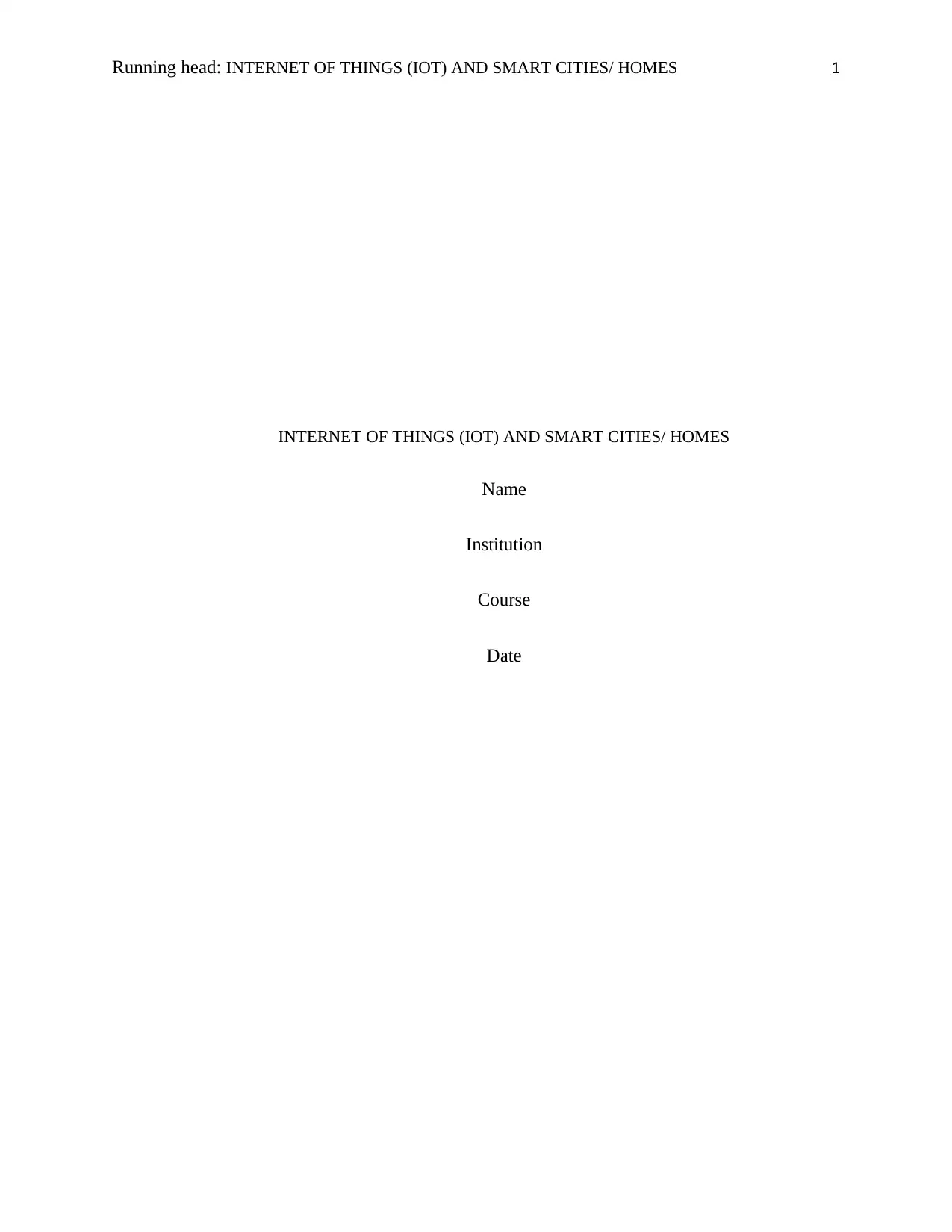
Running head: INTERNET OF THINGS (IOT) AND SMART CITIES/ HOMES 1
INTERNET OF THINGS (IOT) AND SMART CITIES/ HOMES
Name
Institution
Course
Date
INTERNET OF THINGS (IOT) AND SMART CITIES/ HOMES
Name
Institution
Course
Date
Paraphrase This Document
Need a fresh take? Get an instant paraphrase of this document with our AI Paraphraser
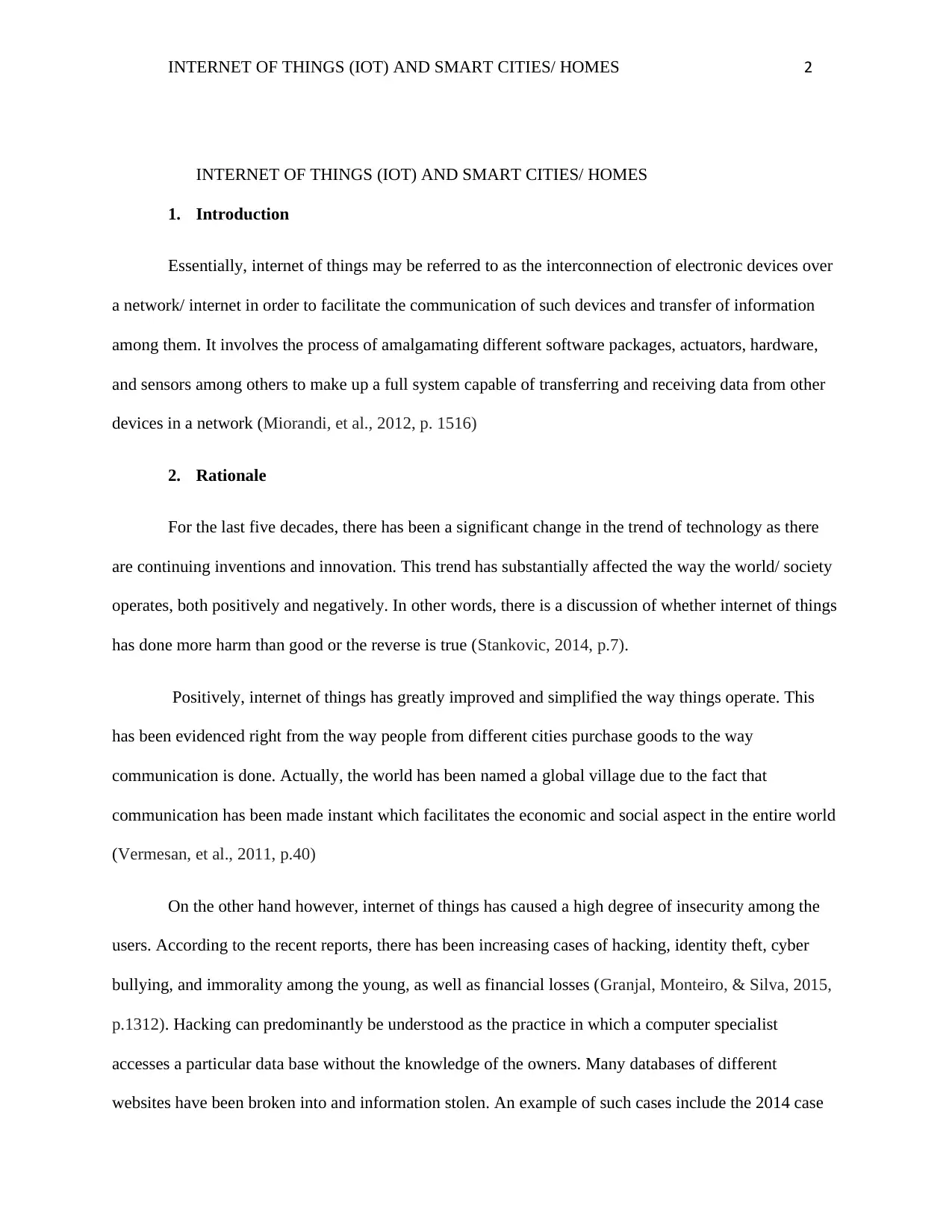
INTERNET OF THINGS (IOT) AND SMART CITIES/ HOMES 2
INTERNET OF THINGS (IOT) AND SMART CITIES/ HOMES
1. Introduction
Essentially, internet of things may be referred to as the interconnection of electronic devices over
a network/ internet in order to facilitate the communication of such devices and transfer of information
among them. It involves the process of amalgamating different software packages, actuators, hardware,
and sensors among others to make up a full system capable of transferring and receiving data from other
devices in a network (Miorandi, et al., 2012, p. 1516)
2. Rationale
For the last five decades, there has been a significant change in the trend of technology as there
are continuing inventions and innovation. This trend has substantially affected the way the world/ society
operates, both positively and negatively. In other words, there is a discussion of whether internet of things
has done more harm than good or the reverse is true (Stankovic, 2014, p.7).
Positively, internet of things has greatly improved and simplified the way things operate. This
has been evidenced right from the way people from different cities purchase goods to the way
communication is done. Actually, the world has been named a global village due to the fact that
communication has been made instant which facilitates the economic and social aspect in the entire world
(Vermesan, et al., 2011, p.40)
On the other hand however, internet of things has caused a high degree of insecurity among the
users. According to the recent reports, there has been increasing cases of hacking, identity theft, cyber
bullying, and immorality among the young, as well as financial losses (Granjal, Monteiro, & Silva, 2015,
p.1312). Hacking can predominantly be understood as the practice in which a computer specialist
accesses a particular data base without the knowledge of the owners. Many databases of different
websites have been broken into and information stolen. An example of such cases include the 2014 case
INTERNET OF THINGS (IOT) AND SMART CITIES/ HOMES
1. Introduction
Essentially, internet of things may be referred to as the interconnection of electronic devices over
a network/ internet in order to facilitate the communication of such devices and transfer of information
among them. It involves the process of amalgamating different software packages, actuators, hardware,
and sensors among others to make up a full system capable of transferring and receiving data from other
devices in a network (Miorandi, et al., 2012, p. 1516)
2. Rationale
For the last five decades, there has been a significant change in the trend of technology as there
are continuing inventions and innovation. This trend has substantially affected the way the world/ society
operates, both positively and negatively. In other words, there is a discussion of whether internet of things
has done more harm than good or the reverse is true (Stankovic, 2014, p.7).
Positively, internet of things has greatly improved and simplified the way things operate. This
has been evidenced right from the way people from different cities purchase goods to the way
communication is done. Actually, the world has been named a global village due to the fact that
communication has been made instant which facilitates the economic and social aspect in the entire world
(Vermesan, et al., 2011, p.40)
On the other hand however, internet of things has caused a high degree of insecurity among the
users. According to the recent reports, there has been increasing cases of hacking, identity theft, cyber
bullying, and immorality among the young, as well as financial losses (Granjal, Monteiro, & Silva, 2015,
p.1312). Hacking can predominantly be understood as the practice in which a computer specialist
accesses a particular data base without the knowledge of the owners. Many databases of different
websites have been broken into and information stolen. An example of such cases include the 2014 case
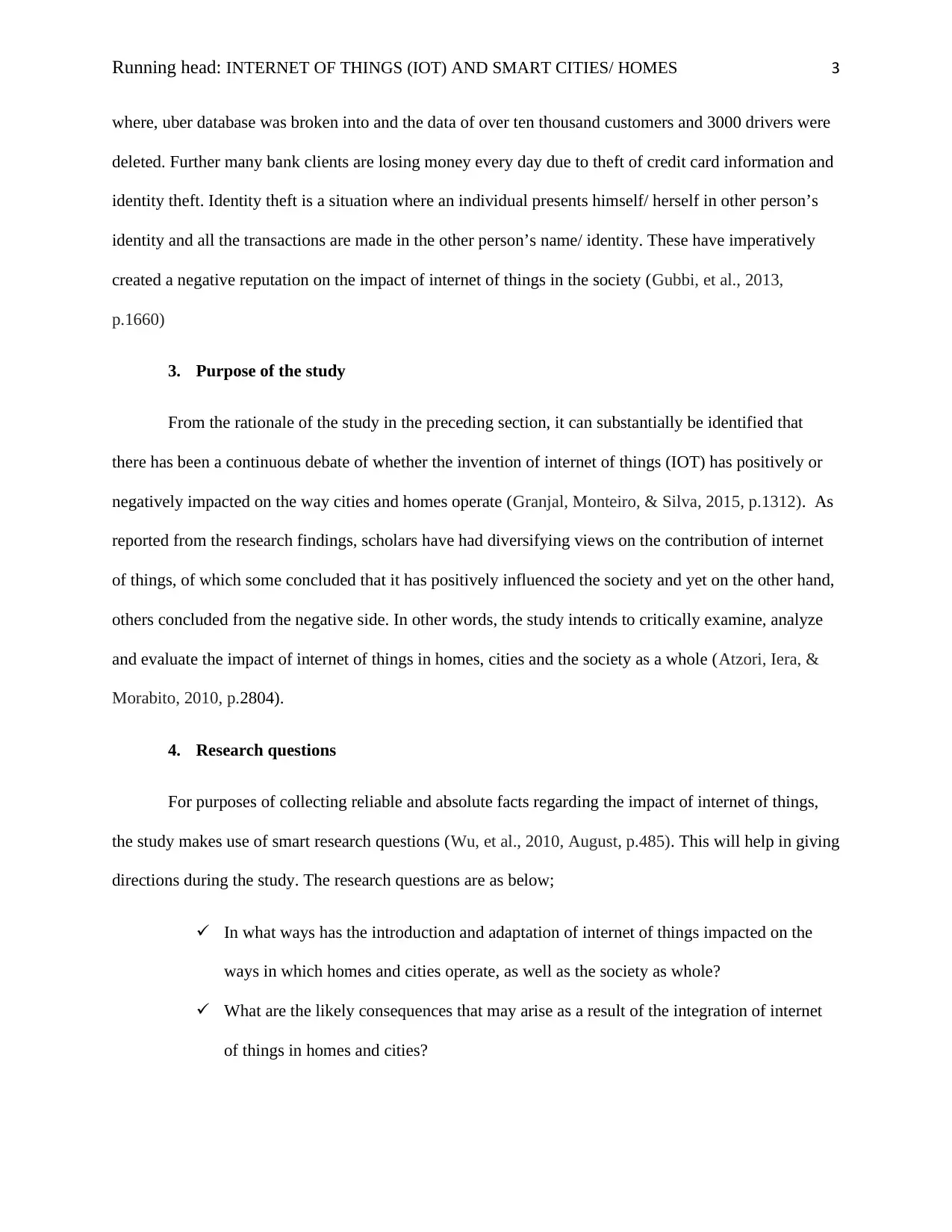
Running head: INTERNET OF THINGS (IOT) AND SMART CITIES/ HOMES 3
where, uber database was broken into and the data of over ten thousand customers and 3000 drivers were
deleted. Further many bank clients are losing money every day due to theft of credit card information and
identity theft. Identity theft is a situation where an individual presents himself/ herself in other person’s
identity and all the transactions are made in the other person’s name/ identity. These have imperatively
created a negative reputation on the impact of internet of things in the society (Gubbi, et al., 2013,
p.1660)
3. Purpose of the study
From the rationale of the study in the preceding section, it can substantially be identified that
there has been a continuous debate of whether the invention of internet of things (IOT) has positively or
negatively impacted on the way cities and homes operate (Granjal, Monteiro, & Silva, 2015, p.1312). As
reported from the research findings, scholars have had diversifying views on the contribution of internet
of things, of which some concluded that it has positively influenced the society and yet on the other hand,
others concluded from the negative side. In other words, the study intends to critically examine, analyze
and evaluate the impact of internet of things in homes, cities and the society as a whole (Atzori, Iera, &
Morabito, 2010, p.2804).
4. Research questions
For purposes of collecting reliable and absolute facts regarding the impact of internet of things,
the study makes use of smart research questions (Wu, et al., 2010, August, p.485). This will help in giving
directions during the study. The research questions are as below;
In what ways has the introduction and adaptation of internet of things impacted on the
ways in which homes and cities operate, as well as the society as whole?
What are the likely consequences that may arise as a result of the integration of internet
of things in homes and cities?
where, uber database was broken into and the data of over ten thousand customers and 3000 drivers were
deleted. Further many bank clients are losing money every day due to theft of credit card information and
identity theft. Identity theft is a situation where an individual presents himself/ herself in other person’s
identity and all the transactions are made in the other person’s name/ identity. These have imperatively
created a negative reputation on the impact of internet of things in the society (Gubbi, et al., 2013,
p.1660)
3. Purpose of the study
From the rationale of the study in the preceding section, it can substantially be identified that
there has been a continuous debate of whether the invention of internet of things (IOT) has positively or
negatively impacted on the way cities and homes operate (Granjal, Monteiro, & Silva, 2015, p.1312). As
reported from the research findings, scholars have had diversifying views on the contribution of internet
of things, of which some concluded that it has positively influenced the society and yet on the other hand,
others concluded from the negative side. In other words, the study intends to critically examine, analyze
and evaluate the impact of internet of things in homes, cities and the society as a whole (Atzori, Iera, &
Morabito, 2010, p.2804).
4. Research questions
For purposes of collecting reliable and absolute facts regarding the impact of internet of things,
the study makes use of smart research questions (Wu, et al., 2010, August, p.485). This will help in giving
directions during the study. The research questions are as below;
In what ways has the introduction and adaptation of internet of things impacted on the
ways in which homes and cities operate, as well as the society as whole?
What are the likely consequences that may arise as a result of the integration of internet
of things in homes and cities?
⊘ This is a preview!⊘
Do you want full access?
Subscribe today to unlock all pages.

Trusted by 1+ million students worldwide
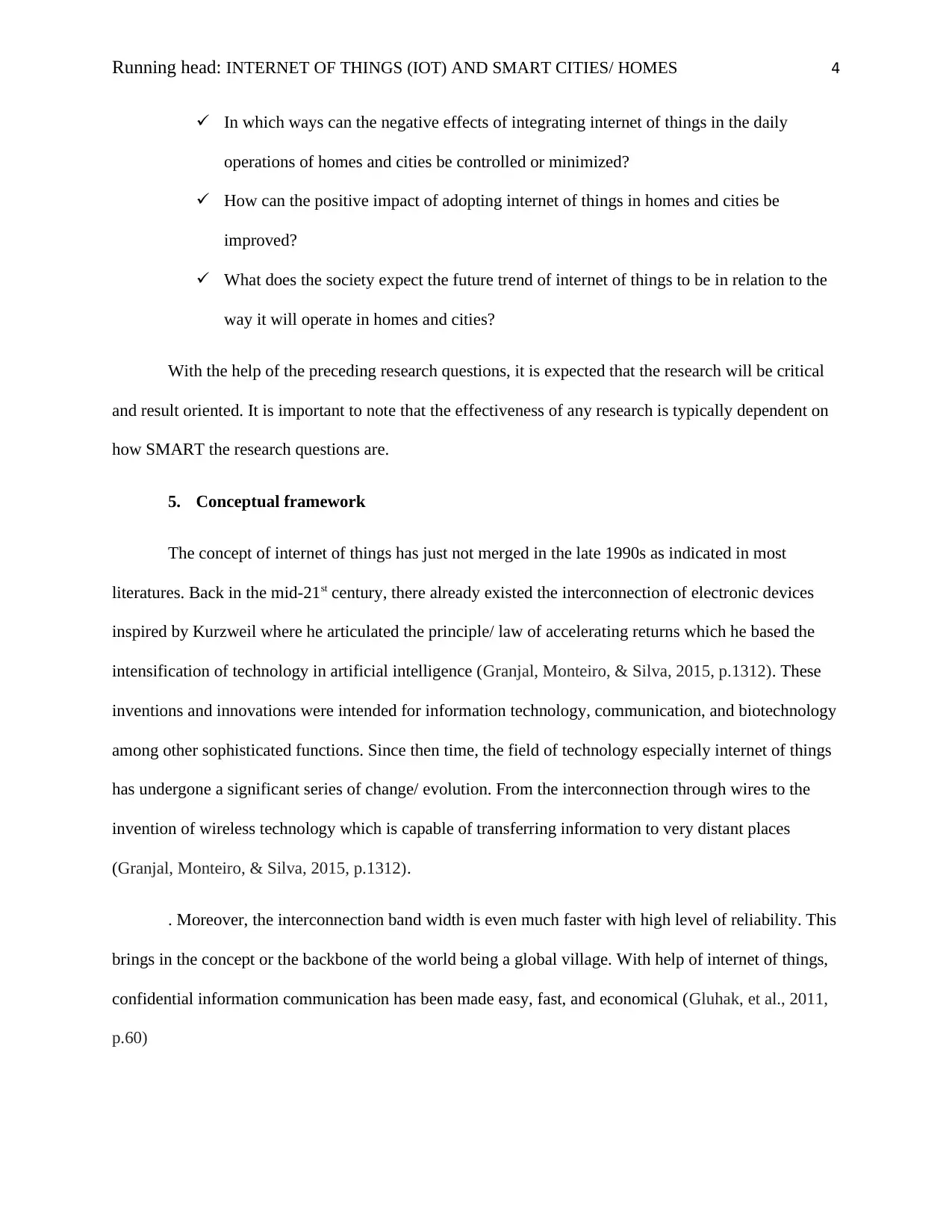
Running head: INTERNET OF THINGS (IOT) AND SMART CITIES/ HOMES 4
In which ways can the negative effects of integrating internet of things in the daily
operations of homes and cities be controlled or minimized?
How can the positive impact of adopting internet of things in homes and cities be
improved?
What does the society expect the future trend of internet of things to be in relation to the
way it will operate in homes and cities?
With the help of the preceding research questions, it is expected that the research will be critical
and result oriented. It is important to note that the effectiveness of any research is typically dependent on
how SMART the research questions are.
5. Conceptual framework
The concept of internet of things has just not merged in the late 1990s as indicated in most
literatures. Back in the mid-21st century, there already existed the interconnection of electronic devices
inspired by Kurzweil where he articulated the principle/ law of accelerating returns which he based the
intensification of technology in artificial intelligence (Granjal, Monteiro, & Silva, 2015, p.1312). These
inventions and innovations were intended for information technology, communication, and biotechnology
among other sophisticated functions. Since then time, the field of technology especially internet of things
has undergone a significant series of change/ evolution. From the interconnection through wires to the
invention of wireless technology which is capable of transferring information to very distant places
(Granjal, Monteiro, & Silva, 2015, p.1312).
. Moreover, the interconnection band width is even much faster with high level of reliability. This
brings in the concept or the backbone of the world being a global village. With help of internet of things,
confidential information communication has been made easy, fast, and economical (Gluhak, et al., 2011,
p.60)
In which ways can the negative effects of integrating internet of things in the daily
operations of homes and cities be controlled or minimized?
How can the positive impact of adopting internet of things in homes and cities be
improved?
What does the society expect the future trend of internet of things to be in relation to the
way it will operate in homes and cities?
With the help of the preceding research questions, it is expected that the research will be critical
and result oriented. It is important to note that the effectiveness of any research is typically dependent on
how SMART the research questions are.
5. Conceptual framework
The concept of internet of things has just not merged in the late 1990s as indicated in most
literatures. Back in the mid-21st century, there already existed the interconnection of electronic devices
inspired by Kurzweil where he articulated the principle/ law of accelerating returns which he based the
intensification of technology in artificial intelligence (Granjal, Monteiro, & Silva, 2015, p.1312). These
inventions and innovations were intended for information technology, communication, and biotechnology
among other sophisticated functions. Since then time, the field of technology especially internet of things
has undergone a significant series of change/ evolution. From the interconnection through wires to the
invention of wireless technology which is capable of transferring information to very distant places
(Granjal, Monteiro, & Silva, 2015, p.1312).
. Moreover, the interconnection band width is even much faster with high level of reliability. This
brings in the concept or the backbone of the world being a global village. With help of internet of things,
confidential information communication has been made easy, fast, and economical (Gluhak, et al., 2011,
p.60)
Paraphrase This Document
Need a fresh take? Get an instant paraphrase of this document with our AI Paraphraser
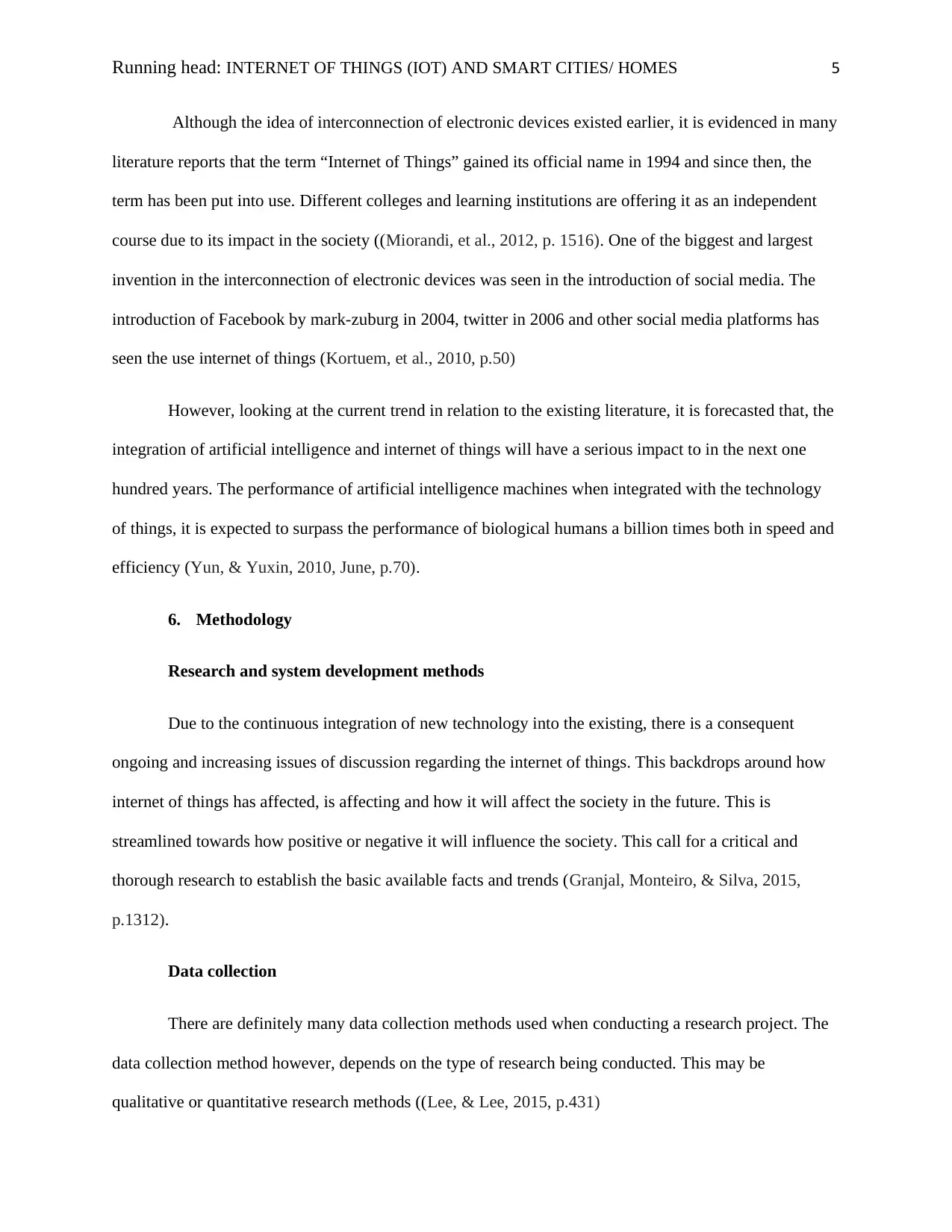
Running head: INTERNET OF THINGS (IOT) AND SMART CITIES/ HOMES 5
Although the idea of interconnection of electronic devices existed earlier, it is evidenced in many
literature reports that the term “Internet of Things” gained its official name in 1994 and since then, the
term has been put into use. Different colleges and learning institutions are offering it as an independent
course due to its impact in the society ((Miorandi, et al., 2012, p. 1516). One of the biggest and largest
invention in the interconnection of electronic devices was seen in the introduction of social media. The
introduction of Facebook by mark-zuburg in 2004, twitter in 2006 and other social media platforms has
seen the use internet of things (Kortuem, et al., 2010, p.50)
However, looking at the current trend in relation to the existing literature, it is forecasted that, the
integration of artificial intelligence and internet of things will have a serious impact to in the next one
hundred years. The performance of artificial intelligence machines when integrated with the technology
of things, it is expected to surpass the performance of biological humans a billion times both in speed and
efficiency (Yun, & Yuxin, 2010, June, p.70).
6. Methodology
Research and system development methods
Due to the continuous integration of new technology into the existing, there is a consequent
ongoing and increasing issues of discussion regarding the internet of things. This backdrops around how
internet of things has affected, is affecting and how it will affect the society in the future. This is
streamlined towards how positive or negative it will influence the society. This call for a critical and
thorough research to establish the basic available facts and trends (Granjal, Monteiro, & Silva, 2015,
p.1312).
Data collection
There are definitely many data collection methods used when conducting a research project. The
data collection method however, depends on the type of research being conducted. This may be
qualitative or quantitative research methods ((Lee, & Lee, 2015, p.431)
Although the idea of interconnection of electronic devices existed earlier, it is evidenced in many
literature reports that the term “Internet of Things” gained its official name in 1994 and since then, the
term has been put into use. Different colleges and learning institutions are offering it as an independent
course due to its impact in the society ((Miorandi, et al., 2012, p. 1516). One of the biggest and largest
invention in the interconnection of electronic devices was seen in the introduction of social media. The
introduction of Facebook by mark-zuburg in 2004, twitter in 2006 and other social media platforms has
seen the use internet of things (Kortuem, et al., 2010, p.50)
However, looking at the current trend in relation to the existing literature, it is forecasted that, the
integration of artificial intelligence and internet of things will have a serious impact to in the next one
hundred years. The performance of artificial intelligence machines when integrated with the technology
of things, it is expected to surpass the performance of biological humans a billion times both in speed and
efficiency (Yun, & Yuxin, 2010, June, p.70).
6. Methodology
Research and system development methods
Due to the continuous integration of new technology into the existing, there is a consequent
ongoing and increasing issues of discussion regarding the internet of things. This backdrops around how
internet of things has affected, is affecting and how it will affect the society in the future. This is
streamlined towards how positive or negative it will influence the society. This call for a critical and
thorough research to establish the basic available facts and trends (Granjal, Monteiro, & Silva, 2015,
p.1312).
Data collection
There are definitely many data collection methods used when conducting a research project. The
data collection method however, depends on the type of research being conducted. This may be
qualitative or quantitative research methods ((Lee, & Lee, 2015, p.431)
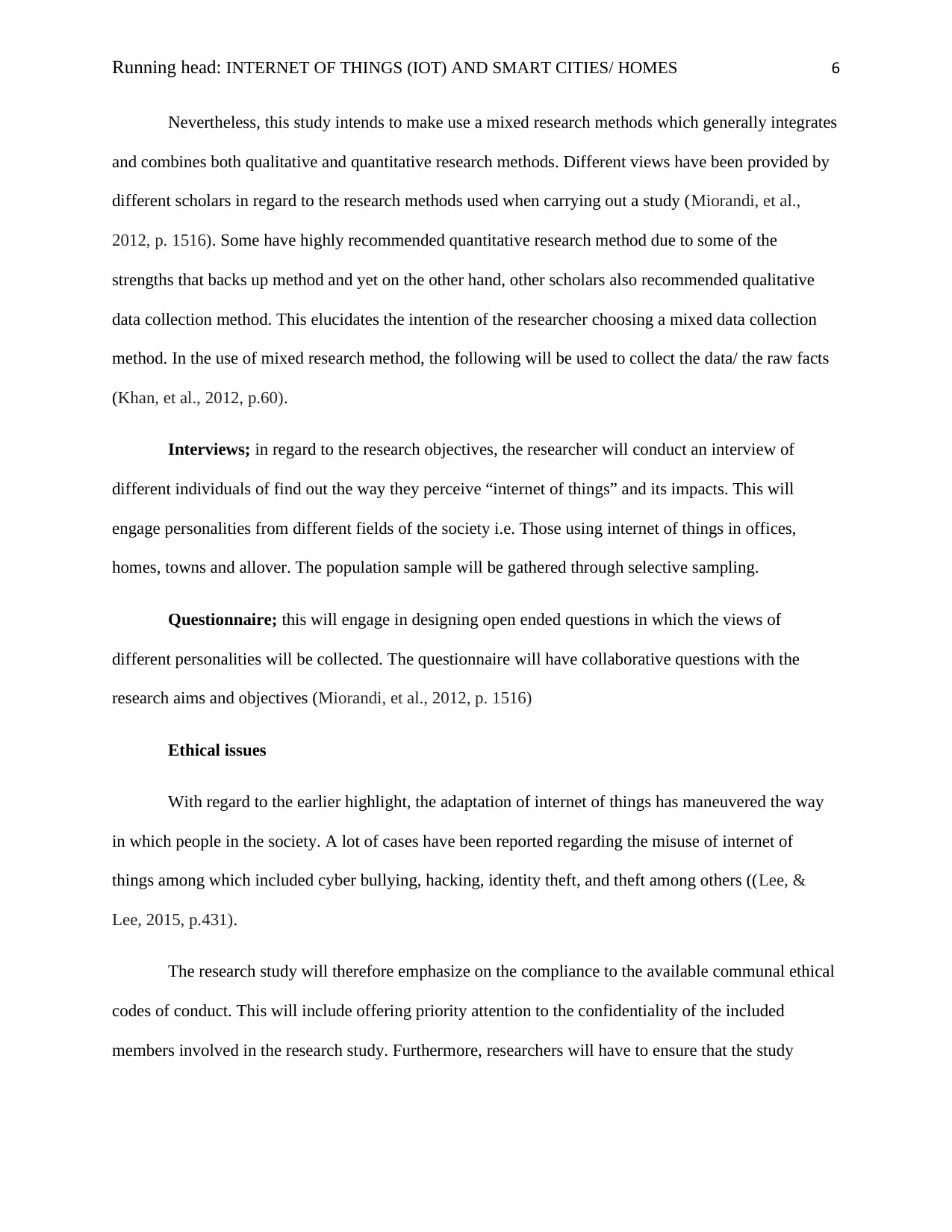
Running head: INTERNET OF THINGS (IOT) AND SMART CITIES/ HOMES 6
Nevertheless, this study intends to make use a mixed research methods which generally integrates
and combines both qualitative and quantitative research methods. Different views have been provided by
different scholars in regard to the research methods used when carrying out a study (Miorandi, et al.,
2012, p. 1516). Some have highly recommended quantitative research method due to some of the
strengths that backs up method and yet on the other hand, other scholars also recommended qualitative
data collection method. This elucidates the intention of the researcher choosing a mixed data collection
method. In the use of mixed research method, the following will be used to collect the data/ the raw facts
(Khan, et al., 2012, p.60).
Interviews; in regard to the research objectives, the researcher will conduct an interview of
different individuals of find out the way they perceive “internet of things” and its impacts. This will
engage personalities from different fields of the society i.e. Those using internet of things in offices,
homes, towns and allover. The population sample will be gathered through selective sampling.
Questionnaire; this will engage in designing open ended questions in which the views of
different personalities will be collected. The questionnaire will have collaborative questions with the
research aims and objectives (Miorandi, et al., 2012, p. 1516)
Ethical issues
With regard to the earlier highlight, the adaptation of internet of things has maneuvered the way
in which people in the society. A lot of cases have been reported regarding the misuse of internet of
things among which included cyber bullying, hacking, identity theft, and theft among others ((Lee, &
Lee, 2015, p.431).
The research study will therefore emphasize on the compliance to the available communal ethical
codes of conduct. This will include offering priority attention to the confidentiality of the included
members involved in the research study. Furthermore, researchers will have to ensure that the study
Nevertheless, this study intends to make use a mixed research methods which generally integrates
and combines both qualitative and quantitative research methods. Different views have been provided by
different scholars in regard to the research methods used when carrying out a study (Miorandi, et al.,
2012, p. 1516). Some have highly recommended quantitative research method due to some of the
strengths that backs up method and yet on the other hand, other scholars also recommended qualitative
data collection method. This elucidates the intention of the researcher choosing a mixed data collection
method. In the use of mixed research method, the following will be used to collect the data/ the raw facts
(Khan, et al., 2012, p.60).
Interviews; in regard to the research objectives, the researcher will conduct an interview of
different individuals of find out the way they perceive “internet of things” and its impacts. This will
engage personalities from different fields of the society i.e. Those using internet of things in offices,
homes, towns and allover. The population sample will be gathered through selective sampling.
Questionnaire; this will engage in designing open ended questions in which the views of
different personalities will be collected. The questionnaire will have collaborative questions with the
research aims and objectives (Miorandi, et al., 2012, p. 1516)
Ethical issues
With regard to the earlier highlight, the adaptation of internet of things has maneuvered the way
in which people in the society. A lot of cases have been reported regarding the misuse of internet of
things among which included cyber bullying, hacking, identity theft, and theft among others ((Lee, &
Lee, 2015, p.431).
The research study will therefore emphasize on the compliance to the available communal ethical
codes of conduct. This will include offering priority attention to the confidentiality of the included
members involved in the research study. Furthermore, researchers will have to ensure that the study
⊘ This is a preview!⊘
Do you want full access?
Subscribe today to unlock all pages.

Trusted by 1+ million students worldwide
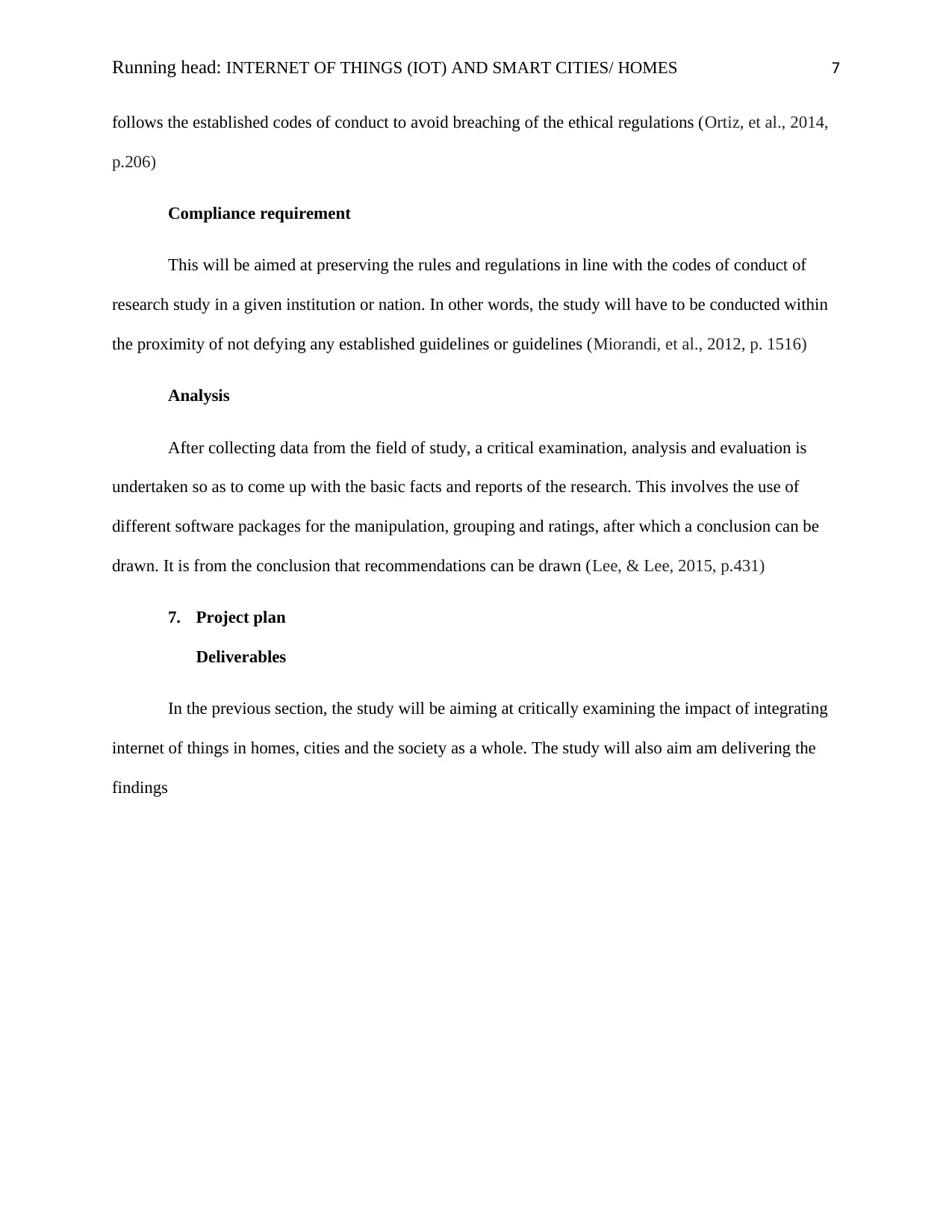
Running head: INTERNET OF THINGS (IOT) AND SMART CITIES/ HOMES 7
follows the established codes of conduct to avoid breaching of the ethical regulations (Ortiz, et al., 2014,
p.206)
Compliance requirement
This will be aimed at preserving the rules and regulations in line with the codes of conduct of
research study in a given institution or nation. In other words, the study will have to be conducted within
the proximity of not defying any established guidelines or guidelines (Miorandi, et al., 2012, p. 1516)
Analysis
After collecting data from the field of study, a critical examination, analysis and evaluation is
undertaken so as to come up with the basic facts and reports of the research. This involves the use of
different software packages for the manipulation, grouping and ratings, after which a conclusion can be
drawn. It is from the conclusion that recommendations can be drawn (Lee, & Lee, 2015, p.431)
7. Project plan
Deliverables
In the previous section, the study will be aiming at critically examining the impact of integrating
internet of things in homes, cities and the society as a whole. The study will also aim am delivering the
findings
follows the established codes of conduct to avoid breaching of the ethical regulations (Ortiz, et al., 2014,
p.206)
Compliance requirement
This will be aimed at preserving the rules and regulations in line with the codes of conduct of
research study in a given institution or nation. In other words, the study will have to be conducted within
the proximity of not defying any established guidelines or guidelines (Miorandi, et al., 2012, p. 1516)
Analysis
After collecting data from the field of study, a critical examination, analysis and evaluation is
undertaken so as to come up with the basic facts and reports of the research. This involves the use of
different software packages for the manipulation, grouping and ratings, after which a conclusion can be
drawn. It is from the conclusion that recommendations can be drawn (Lee, & Lee, 2015, p.431)
7. Project plan
Deliverables
In the previous section, the study will be aiming at critically examining the impact of integrating
internet of things in homes, cities and the society as a whole. The study will also aim am delivering the
findings
Paraphrase This Document
Need a fresh take? Get an instant paraphrase of this document with our AI Paraphraser
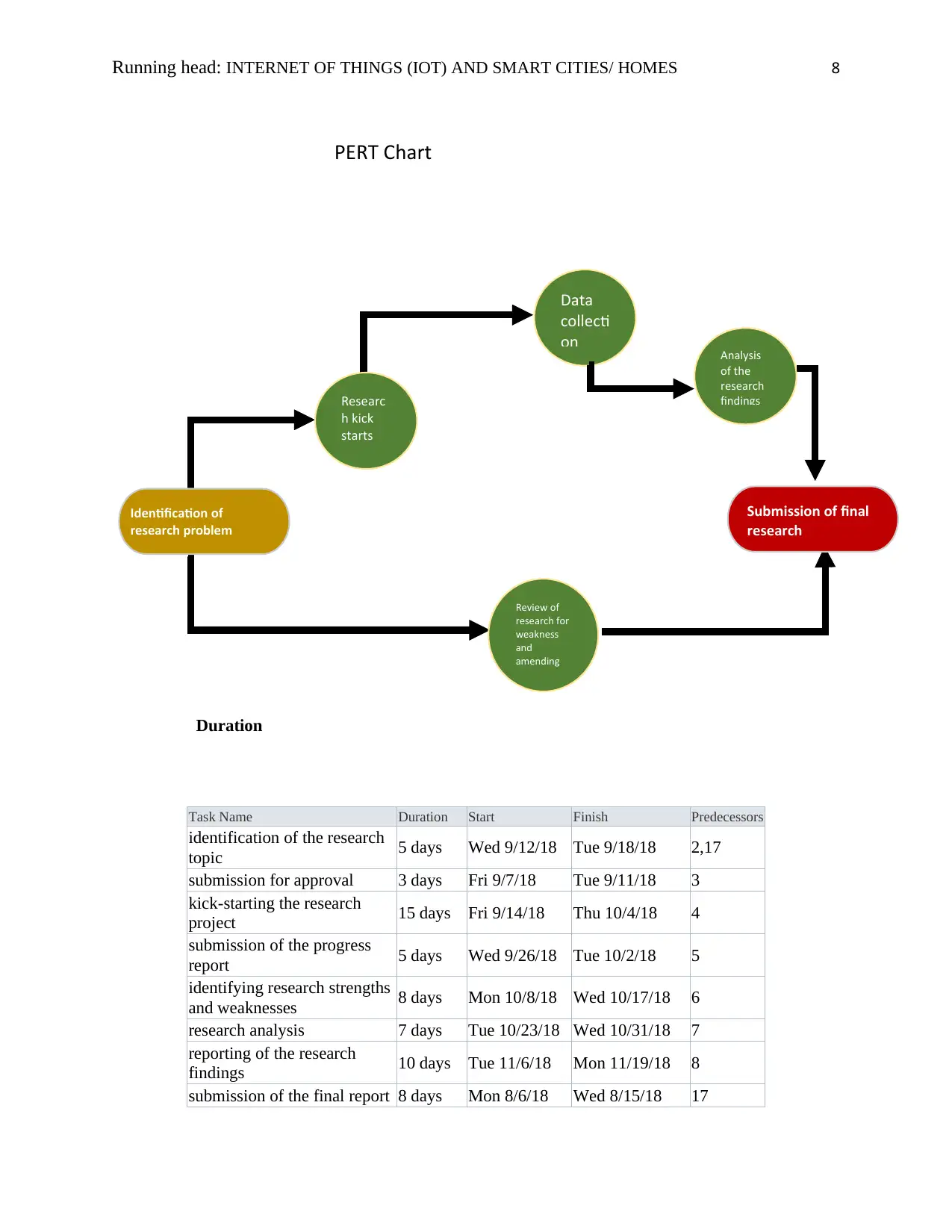
Running head: INTERNET OF THINGS (IOT) AND SMART CITIES/ HOMES 8
Duration
Task Name Duration Start Finish Predecessors
identification of the research
topic 5 days Wed 9/12/18 Tue 9/18/18 2,17
submission for approval 3 days Fri 9/7/18 Tue 9/11/18 3
kick-starting the research
project 15 days Fri 9/14/18 Thu 10/4/18 4
submission of the progress
report 5 days Wed 9/26/18 Tue 10/2/18 5
identifying research strengths
and weaknesses 8 days Mon 10/8/18 Wed 10/17/18 6
research analysis 7 days Tue 10/23/18 Wed 10/31/18 7
reporting of the research
findings 10 days Tue 11/6/18 Mon 11/19/18 8
submission of the final report 8 days Mon 8/6/18 Wed 8/15/18 17
Identification of
research problem
Data
collecti
on
Researc
h kick
starts
Submission of final
research
Review of
research for
weakness
and
amending
Analysis
of the
research
findings
PERT Chart
Duration
Task Name Duration Start Finish Predecessors
identification of the research
topic 5 days Wed 9/12/18 Tue 9/18/18 2,17
submission for approval 3 days Fri 9/7/18 Tue 9/11/18 3
kick-starting the research
project 15 days Fri 9/14/18 Thu 10/4/18 4
submission of the progress
report 5 days Wed 9/26/18 Tue 10/2/18 5
identifying research strengths
and weaknesses 8 days Mon 10/8/18 Wed 10/17/18 6
research analysis 7 days Tue 10/23/18 Wed 10/31/18 7
reporting of the research
findings 10 days Tue 11/6/18 Mon 11/19/18 8
submission of the final report 8 days Mon 8/6/18 Wed 8/15/18 17
Identification of
research problem
Data
collecti
on
Researc
h kick
starts
Submission of final
research
Review of
research for
weakness
and
amending
Analysis
of the
research
findings
PERT Chart
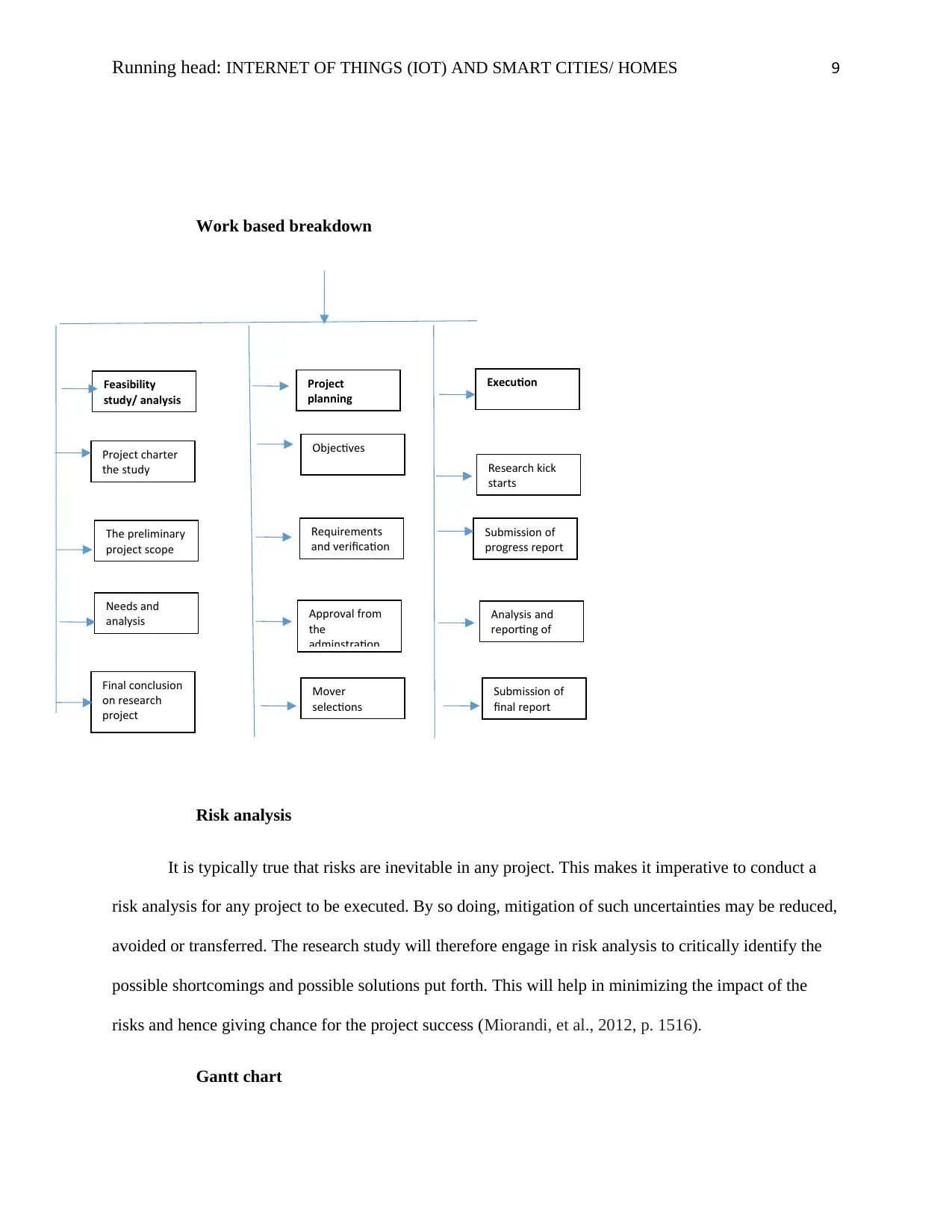
Running head: INTERNET OF THINGS (IOT) AND SMART CITIES/ HOMES 9
Work based breakdown
Risk analysis
It is typically true that risks are inevitable in any project. This makes it imperative to conduct a
risk analysis for any project to be executed. By so doing, mitigation of such uncertainties may be reduced,
avoided or transferred. The research study will therefore engage in risk analysis to critically identify the
possible shortcomings and possible solutions put forth. This will help in minimizing the impact of the
risks and hence giving chance for the project success (Miorandi, et al., 2012, p. 1516).
Gantt chart
Project charter
the study
The preliminary
project scope
ExecutionProject
planning
Feasibility
study/ analysis
Final conclusion
on research
project
Needs and
analysis
Submission of
progress report
Objectives
Requirements
and verification
Approval from
the
adminstration
Mover
selections
Analysis and
reporting of
Submission of
final report
Research kick
starts
Work based breakdown
Risk analysis
It is typically true that risks are inevitable in any project. This makes it imperative to conduct a
risk analysis for any project to be executed. By so doing, mitigation of such uncertainties may be reduced,
avoided or transferred. The research study will therefore engage in risk analysis to critically identify the
possible shortcomings and possible solutions put forth. This will help in minimizing the impact of the
risks and hence giving chance for the project success (Miorandi, et al., 2012, p. 1516).
Gantt chart
Project charter
the study
The preliminary
project scope
ExecutionProject
planning
Feasibility
study/ analysis
Final conclusion
on research
project
Needs and
analysis
Submission of
progress report
Objectives
Requirements
and verification
Approval from
the
adminstration
Mover
selections
Analysis and
reporting of
Submission of
final report
Research kick
starts
⊘ This is a preview!⊘
Do you want full access?
Subscribe today to unlock all pages.

Trusted by 1+ million students worldwide
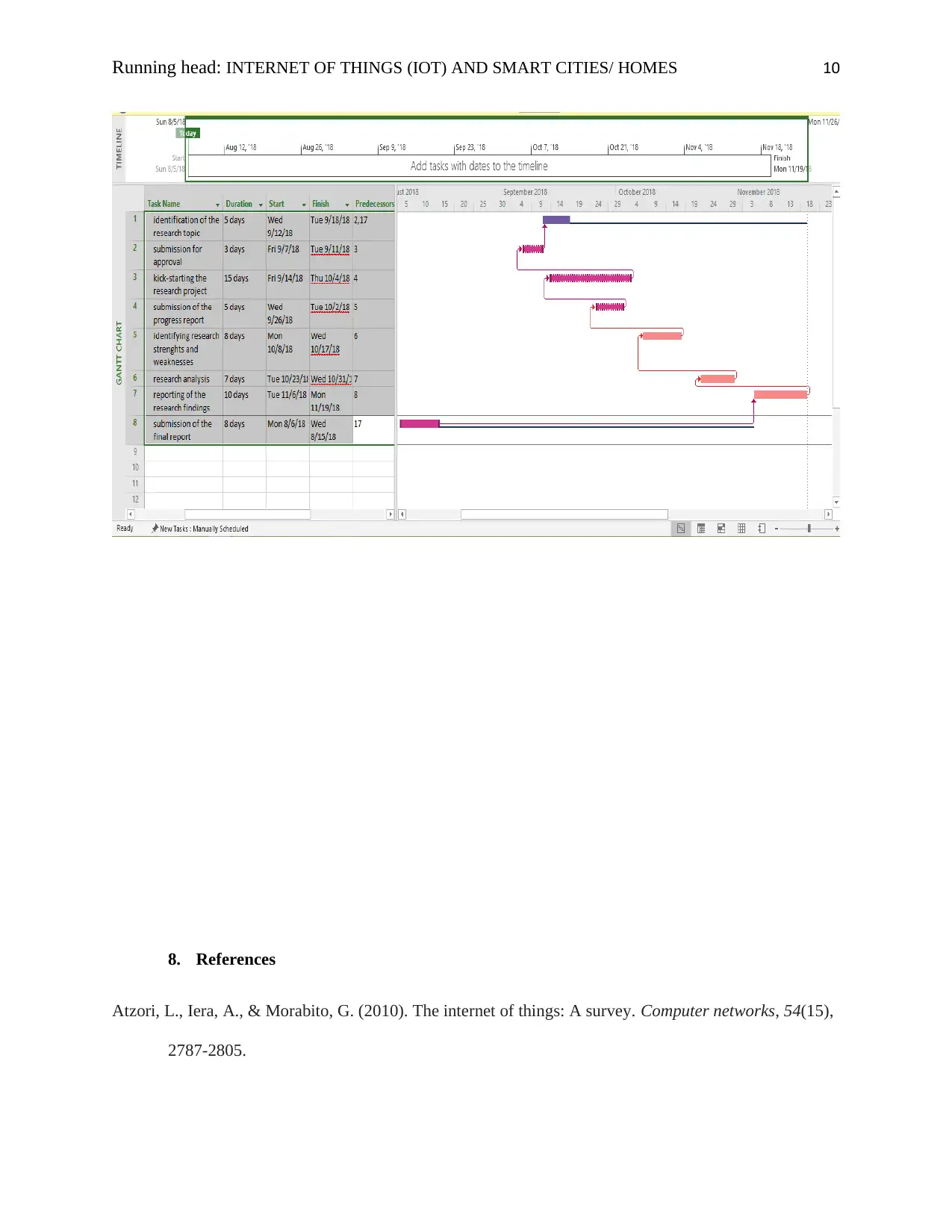
Running head: INTERNET OF THINGS (IOT) AND SMART CITIES/ HOMES 10
8. References
Atzori, L., Iera, A., & Morabito, G. (2010). The internet of things: A survey. Computer networks, 54(15),
2787-2805.
8. References
Atzori, L., Iera, A., & Morabito, G. (2010). The internet of things: A survey. Computer networks, 54(15),
2787-2805.
Paraphrase This Document
Need a fresh take? Get an instant paraphrase of this document with our AI Paraphraser
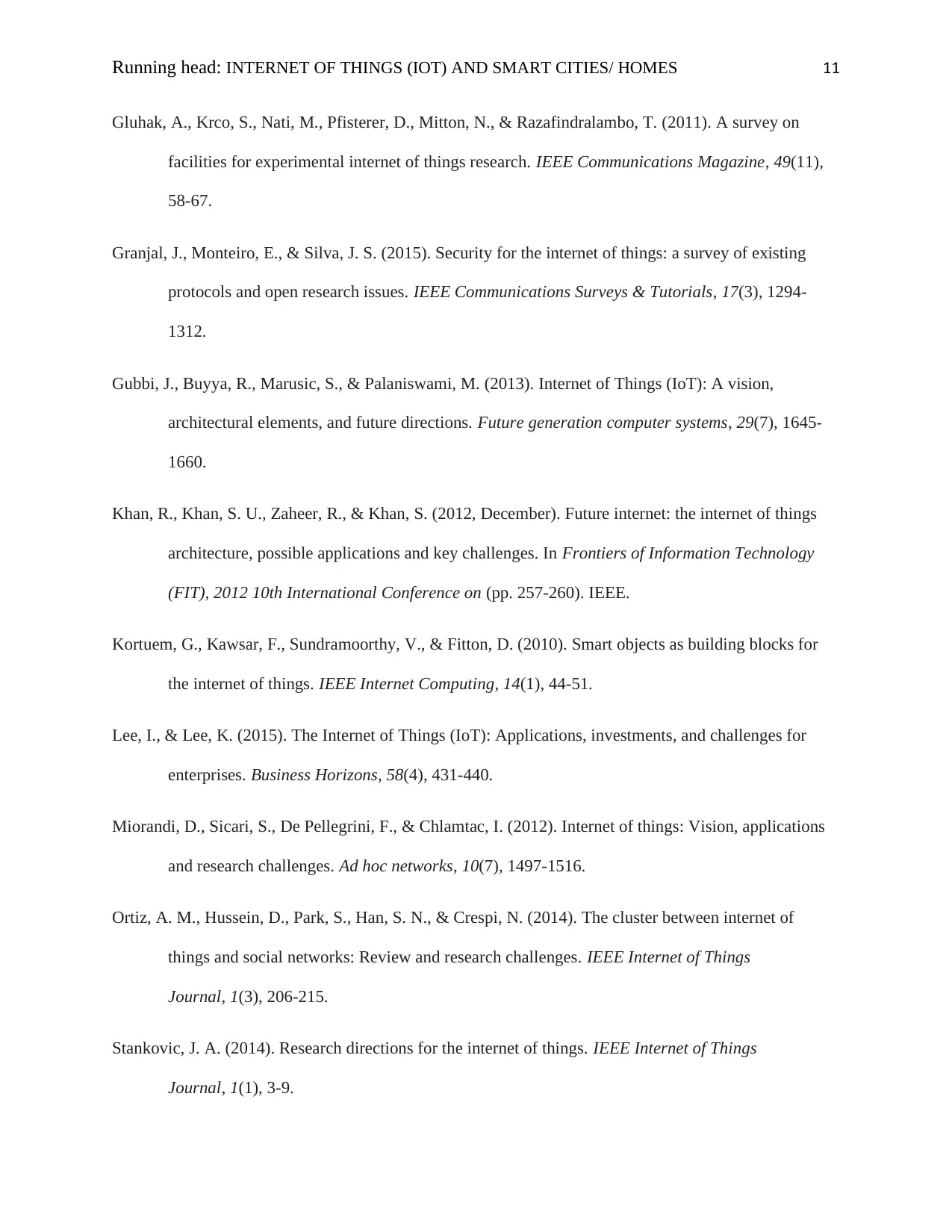
Running head: INTERNET OF THINGS (IOT) AND SMART CITIES/ HOMES 11
Gluhak, A., Krco, S., Nati, M., Pfisterer, D., Mitton, N., & Razafindralambo, T. (2011). A survey on
facilities for experimental internet of things research. IEEE Communications Magazine, 49(11),
58-67.
Granjal, J., Monteiro, E., & Silva, J. S. (2015). Security for the internet of things: a survey of existing
protocols and open research issues. IEEE Communications Surveys & Tutorials, 17(3), 1294-
1312.
Gubbi, J., Buyya, R., Marusic, S., & Palaniswami, M. (2013). Internet of Things (IoT): A vision,
architectural elements, and future directions. Future generation computer systems, 29(7), 1645-
1660.
Khan, R., Khan, S. U., Zaheer, R., & Khan, S. (2012, December). Future internet: the internet of things
architecture, possible applications and key challenges. In Frontiers of Information Technology
(FIT), 2012 10th International Conference on (pp. 257-260). IEEE.
Kortuem, G., Kawsar, F., Sundramoorthy, V., & Fitton, D. (2010). Smart objects as building blocks for
the internet of things. IEEE Internet Computing, 14(1), 44-51.
Lee, I., & Lee, K. (2015). The Internet of Things (IoT): Applications, investments, and challenges for
enterprises. Business Horizons, 58(4), 431-440.
Miorandi, D., Sicari, S., De Pellegrini, F., & Chlamtac, I. (2012). Internet of things: Vision, applications
and research challenges. Ad hoc networks, 10(7), 1497-1516.
Ortiz, A. M., Hussein, D., Park, S., Han, S. N., & Crespi, N. (2014). The cluster between internet of
things and social networks: Review and research challenges. IEEE Internet of Things
Journal, 1(3), 206-215.
Stankovic, J. A. (2014). Research directions for the internet of things. IEEE Internet of Things
Journal, 1(1), 3-9.
Gluhak, A., Krco, S., Nati, M., Pfisterer, D., Mitton, N., & Razafindralambo, T. (2011). A survey on
facilities for experimental internet of things research. IEEE Communications Magazine, 49(11),
58-67.
Granjal, J., Monteiro, E., & Silva, J. S. (2015). Security for the internet of things: a survey of existing
protocols and open research issues. IEEE Communications Surveys & Tutorials, 17(3), 1294-
1312.
Gubbi, J., Buyya, R., Marusic, S., & Palaniswami, M. (2013). Internet of Things (IoT): A vision,
architectural elements, and future directions. Future generation computer systems, 29(7), 1645-
1660.
Khan, R., Khan, S. U., Zaheer, R., & Khan, S. (2012, December). Future internet: the internet of things
architecture, possible applications and key challenges. In Frontiers of Information Technology
(FIT), 2012 10th International Conference on (pp. 257-260). IEEE.
Kortuem, G., Kawsar, F., Sundramoorthy, V., & Fitton, D. (2010). Smart objects as building blocks for
the internet of things. IEEE Internet Computing, 14(1), 44-51.
Lee, I., & Lee, K. (2015). The Internet of Things (IoT): Applications, investments, and challenges for
enterprises. Business Horizons, 58(4), 431-440.
Miorandi, D., Sicari, S., De Pellegrini, F., & Chlamtac, I. (2012). Internet of things: Vision, applications
and research challenges. Ad hoc networks, 10(7), 1497-1516.
Ortiz, A. M., Hussein, D., Park, S., Han, S. N., & Crespi, N. (2014). The cluster between internet of
things and social networks: Review and research challenges. IEEE Internet of Things
Journal, 1(3), 206-215.
Stankovic, J. A. (2014). Research directions for the internet of things. IEEE Internet of Things
Journal, 1(1), 3-9.
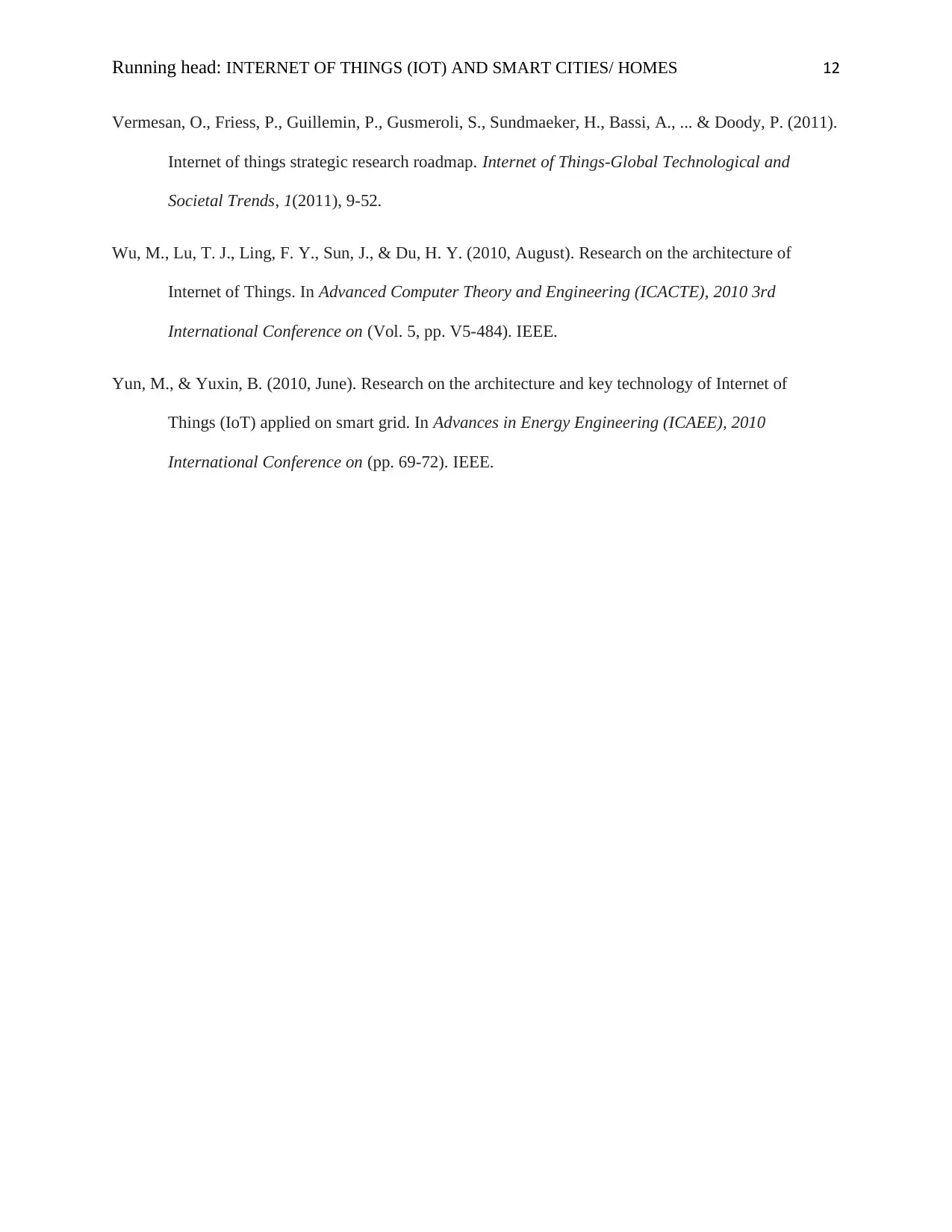
Running head: INTERNET OF THINGS (IOT) AND SMART CITIES/ HOMES 12
Vermesan, O., Friess, P., Guillemin, P., Gusmeroli, S., Sundmaeker, H., Bassi, A., ... & Doody, P. (2011).
Internet of things strategic research roadmap. Internet of Things-Global Technological and
Societal Trends, 1(2011), 9-52.
Wu, M., Lu, T. J., Ling, F. Y., Sun, J., & Du, H. Y. (2010, August). Research on the architecture of
Internet of Things. In Advanced Computer Theory and Engineering (ICACTE), 2010 3rd
International Conference on (Vol. 5, pp. V5-484). IEEE.
Yun, M., & Yuxin, B. (2010, June). Research on the architecture and key technology of Internet of
Things (IoT) applied on smart grid. In Advances in Energy Engineering (ICAEE), 2010
International Conference on (pp. 69-72). IEEE.
Vermesan, O., Friess, P., Guillemin, P., Gusmeroli, S., Sundmaeker, H., Bassi, A., ... & Doody, P. (2011).
Internet of things strategic research roadmap. Internet of Things-Global Technological and
Societal Trends, 1(2011), 9-52.
Wu, M., Lu, T. J., Ling, F. Y., Sun, J., & Du, H. Y. (2010, August). Research on the architecture of
Internet of Things. In Advanced Computer Theory and Engineering (ICACTE), 2010 3rd
International Conference on (Vol. 5, pp. V5-484). IEEE.
Yun, M., & Yuxin, B. (2010, June). Research on the architecture and key technology of Internet of
Things (IoT) applied on smart grid. In Advances in Energy Engineering (ICAEE), 2010
International Conference on (pp. 69-72). IEEE.
⊘ This is a preview!⊘
Do you want full access?
Subscribe today to unlock all pages.

Trusted by 1+ million students worldwide
1 out of 12
Related Documents
Your All-in-One AI-Powered Toolkit for Academic Success.
+13062052269
info@desklib.com
Available 24*7 on WhatsApp / Email
![[object Object]](/_next/static/media/star-bottom.7253800d.svg)
Unlock your academic potential
Copyright © 2020–2025 A2Z Services. All Rights Reserved. Developed and managed by ZUCOL.





